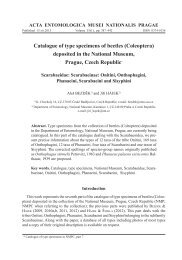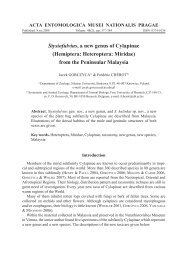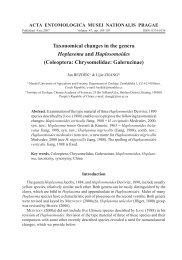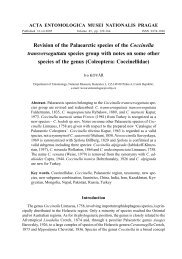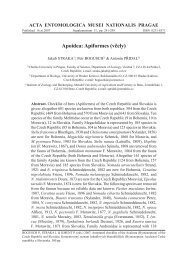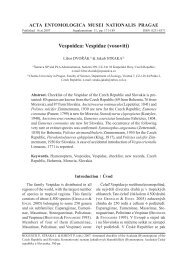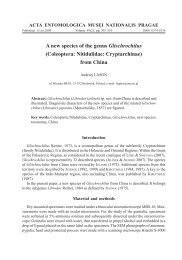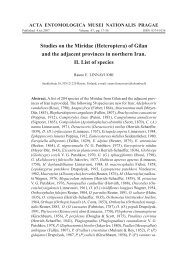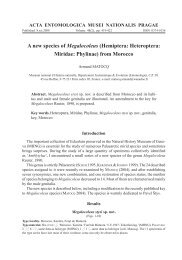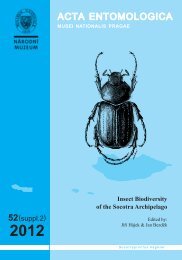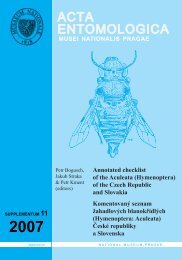Hemiptera: Heteroptera: Aradidae - Acta Entomologica Musei
Hemiptera: Heteroptera: Aradidae - Acta Entomologica Musei
Hemiptera: Heteroptera: Aradidae - Acta Entomologica Musei
You also want an ePaper? Increase the reach of your titles
YUMPU automatically turns print PDFs into web optimized ePapers that Google loves.
ACTA ENTOMOLOGICA MUSEI NATIONALIS PRAGAE<br />
Published 15.vii.2013 Volume 53(1), pp. 33–38 ISSN 0374-1036<br />
http://zoobank.org/urn:lsid:zoobank.org:pub:48C648A2-CCBC-4CB7-B0D9-A2027C9AAAB1<br />
Tiomanaptera schwendingeri, a new apterous<br />
carventine flat bug from Malaysia<br />
(<strong>Hemiptera</strong>: <strong>Heteroptera</strong>: <strong>Aradidae</strong>)<br />
Ernst HEISS 1) & Petr BAŇAŘ 2)<br />
1)<br />
Tiroler Landesmuseum, Josef-Schraffl-Strasse 2a, A-6020 Innsbruck, Austria;<br />
e-mail: aradus@aon.at<br />
2)<br />
Czech University of Life Sciences, Faculty of Forestry and Wood Sciences, Department of Forest<br />
Protection and Entomology, Kamýcká 1176, CZ-165 21 Praha 6-Suchdol, Czech Republic;<br />
e-mail: petrbanar@seznam.cz<br />
Abstract. New species of apterous Carventinae, Tiomanaptera schwendingeri<br />
sp. nov., belonging to the so far monotypic genus Tiomanaptera Heiss, 2010, is<br />
described from Malaysia (Terengganu State). The new species is illustrated and<br />
compared with the previously described T. malickyi Heiss, 2010.<br />
Key words. <strong>Hemiptera</strong>, <strong>Heteroptera</strong>, <strong>Aradidae</strong>, Carventinae, Tiomanaptera, new<br />
species, aptery, Malaysia, Oriental Region<br />
Introduction<br />
Stable habitat conditions and food source existing in untouched rainforests are essential<br />
for development and survival of wingless taxa of <strong>Aradidae</strong>. Central mainland Malaysia and<br />
the small islands Tioman, Redang and Berhentian Besar off the East coast of the Malayan<br />
Peninsula can still offer such conditions, and the few apterous Carventinae recorded from<br />
Malaysia were described from there: Apteraradus Drake, 1957, Kiritshenkiana Kormilev,<br />
1976, Morphocoris Kormilev, 1980 (described as Glyptomorpha Kormilev, 1977, preoccupied);<br />
Cameronaptera Heiss, 2010a, and Tiomanaptera Heiss, 2010b (DRAKE 1957; KORMILEV<br />
1976, 1977, 1980; HEISS 2010a,b). Recently a single specimen from Berhentian Besar shares<br />
the unusually long neck and preapical spines on middle and hind femora, characteristic for<br />
the monotypic island genus Tiomanaptera; thus it is recognized as a new species of this genus<br />
which is described and figured herein.
34<br />
HEISS & BAŇAŘ: A new apterous Tiomanaptera from Malaysia (<strong>Aradidae</strong>)<br />
Material and methods<br />
The specimen this study is based on is preserved in the Muséum d’Histoire Naturelle de<br />
Geneve (MHNG). Incrustations obscuring the body were removed, and the body was cleaned<br />
to study its structures. Colour photographs (Figs 1–4) were taken by Leica MSV266. Drawings<br />
were made using stereoscopic microscope SZP 11 ZOOM.<br />
Measurements, given in milimeters, were taken with a micrometer eyepiece.<br />
A slash (/) separates the lines when citing the text on the labels attached to the specimen.<br />
Abbreviations used: deltg = dorsal external laterotergite (connexivum), mtg = mediotergite.<br />
The following specimen was studied and figured for the comparative purposes:<br />
T. malickyi Heiss, 2010: (MHNG): ‘AS-WM07/7 W-Malaysia / Tioman Island, path from / Kg. Paya to Gunung<br />
/ Kajang, 200-600m, / 02°46‘84‘‘N, 104°07‘63‘‘E / 6.-7.VI.2007, leg. A. Schulz. / AS-WM07/7’.<br />
Taxonomy<br />
Tiomanaptera schwendingeri sp. nov.<br />
(Figs 1, 3, 5, 6)<br />
Type locality. Malaysia, Terengganu State, Pulau Perhentian Besar, trail across island from Teluk Pauh to Teluk<br />
Dalam, 5°53′51″N 102°44′53″E), 50–100 m a.s.l.<br />
Material examined. HOLOTYPE: , ‘THMA-08/01: W- / Malaysia: Terengganu / State, Pulau Perhentian / Besar, trail<br />
across island, / from Teluk Pauh to Teluk / Dalam (5°53’51’’N / 102°44’53’’E), 50-100m / (evergreen rainforest), 2- /<br />
4 VI 2008, leg. P. Schwendinger THMA-08/01’; printed label. This specimen is designated as holotype and labelled<br />
with printed red label: ‘HOLOTYPE / Tiomanaptera / schwendingeri sp. nov. / des. E. HEISS & P. BAŇAŘ 2013’.<br />
Deposited in MHNG. Antennal segments III and IV on left antenna are missing.<br />
Description. Apterous female of medium size (5.1 mm); surface of body rugose and glabrous,<br />
colouration piceous brown; middle and hind femora with preapical spines.<br />
Head. Including neck distinctly longer than width across eyes (1.35/0.75 mm); clypeus<br />
embraced by anteriorly contiguous, laterally expanded genae, reaching 0.5 antennal segment<br />
I; antenniferous lobes directed anterolaterally, apex rounded; antennae with segment I thickest<br />
and curved, II thinner and shorter than segment I, III thinnest and longest, IV fusiform,<br />
antennal formula (longest segment first): III-I-IV-II. Eyes oval, postocular lobes granulate,<br />
converging to neck; neck long and cylindrical; vertex raised medially, flanked by 2 (1+1)<br />
oval impressions. Rostrum arising from a slit-like atrium, shorter than head, rostral groove<br />
deep with carinate borders, closed posteriorly.<br />
Pronotum. Rectangular, twice as wide as long (1.3/0.65mm); consisting of a narrower ring<br />
like anterior collar which is triangularly produced posteriorly and separated from posterior<br />
lobe by a deep suture; lateral margins of posterior lobe parallel, anterolateral angles with a<br />
distinct tubercle, surface with rugosities, granulate on lateral lobes; posterior margin delimited<br />
by a transverse, slightly convex carina separating it from mesonotum.<br />
Mesonotum. Median rhomboidal plate rugose at base, smooth and raised posteriorly;<br />
lateral sclerites consisting each of a small oval elevation and raised lateral lobes with rugose<br />
surface, fused to metanotum, separated by a thin suture.<br />
Metanotum. Split medially by the triangular projection of mesonotal elevation, which<br />
reaches anterior margin of mtg I+II, into two lateral triangular sclerites, their surface smooth<br />
on inner angle and rugose on lateral lobes.
<strong>Acta</strong> <strong>Entomologica</strong> <strong>Musei</strong> Nationalis Pragae, 53(1), 2013 35<br />
Figs 1–4. Habitus of Tiomanaptera species. 1, 3 – T. schwendingeri sp. nov., holotype female; 2, 4 – T. malickyi<br />
Heiss, 2010, female, Tioman Island; 1, 2 – dorsal view; 3, 4 – lateral view. Scale bar = 1.0 mm.
36<br />
HEISS & BAŇAŘ: A new apterous Tiomanaptera from Malaysia (<strong>Aradidae</strong>)<br />
Figs 5–8. Tiomanaptera species. 5, 6 – T. schwendingeri sp. nov., holotype female; 7, 8 – T. malickyi Heiss, 2010,<br />
female, Tioman Island; 5, 7 – tergal plate; 6, 8 – head. Scale bar = 0.5 mm.<br />
Mediotergite I+II. Fused and medially raised with fusion line marked by a transverse suture;<br />
elevation of mtg I consisting of 2 (1+1) posterolaterally inclined ridges separated by a cleft,<br />
sloping laterally; elevation of mtg II narrower and rounded, a longitudinal suture separating<br />
the two lobes; posterior margin straight, a deep groove separates it from tergal plate.<br />
Abdomen. Median elevation increasing in size and height towards mtg III, highest on<br />
anterior margin; laterally with deep depressions marking the apodemal impressions; deltg I+II<br />
fused to a triangular sclerite reaching anteriorly to midlength of mesonotum; deltg III–VII<br />
separated by sutures, lateral margins subparallel, rounded posteriorly, their surface with round
<strong>Acta</strong> <strong>Entomologica</strong> <strong>Musei</strong> Nationalis Pragae, 53(1), 2013 37<br />
callosities on inner half, laterally rugose; posterolaterally produced tubercles of deltg VI and<br />
VII. Due to the displaced segments VIII+IX no structural details can be given.<br />
Venter. Prosternum with a triangular median elevation, fused to meso- and metasternum<br />
and sternite II, fusion lines marked by transverse sutures; median plate of meso-metasternum<br />
and sternite II with a shallow depression; sternites III–VII separated by distinct sutures,<br />
surface of sternites III–VI smooth in middle, lateral parts and pleural regions of thorax with<br />
rugosities; spiracles II placed on a lateral tubercle and visible from above, III+IV sublateral<br />
and hardly visible, V lateral and visible, VI and VII apical on prominent posterolateral angles,<br />
VIII terminal on paratergites VIII.<br />
Legs. Middle and hind femora with long preapical spines, tibiae cylindrical, tarsi twosegmented,<br />
claws with long pulvilli.<br />
Measurements. Body length 5.1 mm; length / width ratio of mesonotum 0.5 / 1.6 mm,<br />
width of metanotum 1.55 mm; length / width ratio of mtg I+II 0.7 / 1.5 mm; length / width<br />
ratio of tergal plate 1.15 / 1.45 mm; width of abdomen across tergites: II – 2.25 mm, III – 2.30<br />
mm, IV – 2.305 mm, V – 2.30 mm, VI – 2.1 mm, VII – 1.6 mm.<br />
Differential diagnosis. Only one species is described in the apterous Carventinae genus<br />
Tiomanaptera (HEISS 2010b) – T. malickyi (Figs 2, 4, 7, 8) from the Tioman Island east of<br />
mainland Malaysia. The new species shares with that species the general habitus and femora<br />
armed with distinct preapical spines. It differs, however, from the latter in shorter genae,<br />
longer neck, strongly elevated median ridge of meso- and metanotum and fused mtg I+II,<br />
and in more distinct apodemal impressions on tergal plate.<br />
Etymology. The species is named in honour of our friend and collector of this interesting species,<br />
Dr. Peter Schwendinger, curator at the Muséum d’histoire naturelle de la Ville de Genève.<br />
Habitat. The single specimen of T. schwendingeri sp. nov. was sifted in primary rainforest<br />
close the footpath along tiny stream.<br />
Distribution. West Malaysia, Perhentian Besar Island, largest island from group of Perhentian<br />
Islands.<br />
Discussion<br />
In <strong>Aradidae</strong>, the elongate cylindrical neck is shared only by the Oriental Carventinae<br />
genera Apteraradus and Tiomanaptera. Considering the variation in size and body structures<br />
among the 6 species of Apteraradus described to date (KORMILEV & FROESCHNER 1987), the<br />
striking difference between these two genera is in the presence of spines on middle and hind<br />
femora of both sexes in Tiomanaptera; they are missing in Apteraradus. As the new species<br />
was collected also on an island east of mainland Malaysia (Berhentian Besar is about 380 km<br />
northwest of Tioman Island, the original locality of T. malickyi), the question may be rised if<br />
the development of femoral spines was related to isolated island conditions, or further species<br />
with this character are yet to be discovered in rainforests of mainland Malaysia.<br />
Acknowledgments<br />
We are grateful to Peter Schwendinger (Muséum d’histoire naturelle de la Ville de Genève)<br />
for the loan of the specimen and Jitka Vilímová (Charles University in Prague) and Lorène
38<br />
HEISS & BAŇAŘ: A new apterous Tiomanaptera from Malaysia (<strong>Aradidae</strong>)<br />
Marchal (Muséum d’histoire naturelle Paris) for reviewing the manuscript. This work was<br />
supported by the Internal Grant Agency (IGA n. 20124364) of the Faculty of Forestry and<br />
Wood Sciences, Czech University of Life Sciences Prague (PB) and Grant of the Faculty of<br />
Science of Charles University in Prague (SVV-2013-267 201) (PB). Petr Baňař would also<br />
like to express his thanks to Peter Schwendinger, John A. Hollier and Ivan Löbl for their<br />
hospitality and help during his visit of Geneva.<br />
References<br />
DRAKE C. J. 1957: New apterous Aradids from the West Indies (<strong>Hemiptera</strong>). Philippine Journal of Science 85:<br />
405–412.<br />
HEISS E. 2010a: Cameronaptera glabrinotum n. gen., n. sp. from Malaysia (<strong>Hemiptera</strong>: <strong>Heteroptera</strong>: <strong>Aradidae</strong>).<br />
Zootaxa 2530: 65–68.<br />
HEISS E. 2010b: A new genus and species of apterous Carventinae from Malaysia (<strong>Heteroptera</strong>, <strong>Aradidae</strong>). Denisia<br />
29: 133–138.<br />
KORMILEV N. A. 1976: On the <strong>Aradidae</strong> from the Old and New World (<strong>Hemiptera</strong>, <strong>Heteroptera</strong>). Zoologica<br />
Scripta 5: 65–78.<br />
KORMILEV N. A. 1977: <strong>Aradidae</strong> from the Oriental and Australian Regions in the collection of the Californian<br />
Academy of Sciences, San Francisco (<strong>Hemiptera</strong>: <strong>Heteroptera</strong>). Transactions of the American <strong>Entomologica</strong>l<br />
Society 103: 603–622.<br />
KORMILEV N. A. 1980: Homonymy in the <strong>Aradidae</strong> (<strong>Hemiptera</strong>). Pacifi c Insects 22: 328.<br />
KORMILEV N. A. & FROESCHNER R. C. 1987: Flat bugs of the World. A synonymic list. (<strong>Heteroptera</strong>: <strong>Aradidae</strong>).<br />
Entomography 5: 1–246.



